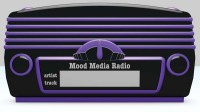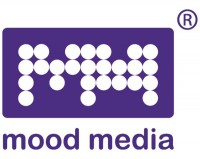 Mood Media Corporation is a leading international in-store media specialist that uses a mix of music, visual and scent media to help its clients communicate with consumers and drive incremental sales at the point of purchase. Leading blue-chip grocery sector clients include The Co-operative, Carrefour, Wal-Mart, M&S and Sainsbury’s.
Mood Media Corporation is a leading international in-store media specialist that uses a mix of music, visual and scent media to help its clients communicate with consumers and drive incremental sales at the point of purchase. Leading blue-chip grocery sector clients include The Co-operative, Carrefour, Wal-Mart, M&S and Sainsbury’s.
Mood Media has an unparalleled client base of major luxury and retail brands, for whom it drives success across its global network. It operates through two principal divisions, driving return on investment at the point of purchase – In-Store Media and Retail Point-of-Purchase, and works with over 850 international brands in 470,000 commercial locations, in more than 40 countries throughout North America, Europe, Asia and Australia, the largest worldwide footprint of any similar provider in the world.
Mood Media bought Muzak in 2010, bringing this household name into the group. It continues growing through sales expansion and further strategic acquisitions and partnerships, which give it a huge collection of media catalogues, professional talent, and an unmatched global retail reach. Mick Bennett, Mood Media’s Managing Director for the UK & Ireland, spoke to The Grocery Trader.
GT – What different in-store marketing services does Mood Media offer?
Our sensorial marketing solutions include digital signage, branded music, in-store radio and scent marketing. We also have a creative services department, which generates visual content, apps and branded QR codes.
GT – Can you talk us through how you work?
We are end to end solution providers. As marketing consultants working with brands from the retail, leisure and hospitality sectors for over 75 years, we can advise clients on what works best at the point of purchase, create an ideal solution and implement it. We act as content designers for in-store radio, screens and scent, creating a retail environment consistent with the client’s brand.
GT – Do you work with retailers’ existing advertising and promotional agencies?
We often do, in order to give a consistent message above and below the line and greater impact to the customer journey.
GT – What do you offer that the conventional agencies don’t?
 With our in depth understanding of media and design but also retail and brand communications, we offer a much wider, end-to-end solution. Our dedicated team are totally committed to producing content that reflects the client’s brand values, grabs their target audience’s attention and provides the results they are looking for. We can ensure the right message is broadcast in the right way in-store, on national TV, online and through social media integration. Finally, all our services are in house, which makes us different to most of our competitors.
With our in depth understanding of media and design but also retail and brand communications, we offer a much wider, end-to-end solution. Our dedicated team are totally committed to producing content that reflects the client’s brand values, grabs their target audience’s attention and provides the results they are looking for. We can ensure the right message is broadcast in the right way in-store, on national TV, online and through social media integration. Finally, all our services are in house, which makes us different to most of our competitors.
GT – Where are you based in the UK?
We have offices in Keston, Kent, and in Central London off Baker Street.
GT – How are you organised to work with the major retailers?
We cover the whole UK with our experienced sales teams. Each of our 10 account directors looks after certain customers and has different areas of expertise: some are in high street fashion, and others are in banking or grocery.
GT – What areas does your creative services department cover?
Our creative services department covers a wide range of activities. The list includes graphics, visual artwork, motion graphics, copywriting, web, interactive and print display. Our production area provides creative for radio and TV advertising and script copywriting. Our digital media section looks after web streaming, consumer promotions, reward schemes, digital track and album cards, podcasts, mobile interactive and app creation. Our music consultancy services include music solutions, affinity partnerships, composition and music rights.
GT – Who owns MMC?
We are listed on the Toronto Stock Exchange and the London AIM Stock Exchange.
GT – How big is Mood Media worldwide?
We have an enterprise value of US $1bn.
GT – How big are you in the UK and Europe?
On the basis that a client is someone who takes one of our services, we have 23,500 client locations in the UK, from a single restaurant or pub to The Co-operative’s 2,500 sites, making us by far the largest such business in the UK. In Europe we have 112,000 client locations.
GT – What other market sectors are you in besides retail?
 We work in hospitality, hotels, QSR (quick service restaurants), corporate, education and distribution centres. In the corporate area we supply installations, including presentation rooms and video conferencing. In education we have installed music systems for Loughborough University’s sports arena. For distribution centres we have provided paging systems and supplied direct licence music, messaging and staff communications, including health and safety information.
We work in hospitality, hotels, QSR (quick service restaurants), corporate, education and distribution centres. In the corporate area we supply installations, including presentation rooms and video conferencing. In education we have installed music systems for Loughborough University’s sports arena. For distribution centres we have provided paging systems and supplied direct licence music, messaging and staff communications, including health and safety information.
GT – How does the UK rate in terms of demand for your services? How do UK retailers compare with other countries in their appreciation of your offerings?
The demand for music in the UK is the second highest in the world after the US. The demand for digital signage is slower than in the rest of Europe, but it’s catching up now: many retailers know they need display screens but don’t know what to do with them – operators of new malls often put up screens first, then fill them with content.
GT – What kinds of digital signage do you supply?
We offer touch screens, electric shelf edge labels, window screens, video walls, LED displays and digital signage. The key is getting your content strategy right, rather than simply installing screens and that’s where Mood Media can help.
GT – Can you tell us about your in-store music?
We offer various platforms, all in closed format, which means the store manager can’t plug his ipod in! We provide music via satellite, hard drive or on disk.
GT – Who are your clients for in-store music in the UK? How does it work?
Some examples of people we currently supply music to are The Co-operative, Sainsbury’s, Nisa, Homebase, KFC and Arcadia. In-store music can be delivered via a retailer’s IT networks or we can supply it by closed format disk or via satellite. Our music programming is carried out in Keston, where we have seven studios, and is then satellite broadcast to the stores through their preferred method.
GT – Do you run in-store radio as a branded service?
Yes, we do. The Co-operative Radio is completely branded, as are Homebase and Nisa’s in store radio. The Co-operative has four DJ’s a day, the same as a ‘proper’ radio station. Most of our DJ’s have links into the radio business, and many of the voiceovers we use are recognisable from local radio stations.
GT – You bought the Muzak Company last year. How has that changed the service you provide?
 It’s enhanced it considerably. Content is critical to our business, and Muzak has a vast selection of digitally based music and other products that we can now offer to customers as a group. We’re also looking at bringing in best practice from Muzak, in terms of hardware and software. Because of our increased scale, we now also have bigger purchasing power and can offer our clients greater value for money.
It’s enhanced it considerably. Content is critical to our business, and Muzak has a vast selection of digitally based music and other products that we can now offer to customers as a group. We’re also looking at bringing in best practice from Muzak, in terms of hardware and software. Because of our increased scale, we now also have bigger purchasing power and can offer our clients greater value for money.
GT – Do you have any research to prove that UK shoppers like in-store music, and that it increases intent to purchase etc?
Many studies have been carried out on music and messaging in store, supporting the principle that if the consumer feels comfortable in a store because of the music, they are likely to spend more time there. Music at the point of sale increases dwell time, which leads to increased purchasing. Radford University in the USA has carried out a similar study of the effect of music in service environments and how ‘dwell time’ is affected by the level of music.
GT – As it’s Christmas, I’d better ask this question. Do shoppers actually like Christmas carols in store?
Generally shoppers like Christmas carols, but there’s a common misunderstanding in retailing about the use of Christmas music, and we believe that retailers start playing Christmas music in stores too early. We commissioned a YouGov study in October 2010 which showed that people don’t want full-on Christmas music in shops before December, yet a lot of retailers insist on it in parts of the store as early as October. So we have phased Christmas music content in our in-store music, starting from 10% in October and gradually increasing as we get nearer.
GT – Can you vary the music to different times of day and to appeal to different shopper demographics?
Varying the music for the demographic is an integral part of our offering. We work with the retailers’ marketing or brand teams to understand their demographics, and we identify and programme the music according to the profile of the store at that time of day or night.
GT – Do retailers need to have existing sound systems etc, or do you install them?
It’s a bit of both – sometimes retailers have their own speakers and PA, and we simply plug into it. We can also do full supply and installation for everything from a budget system to a top end brand.
GT – Your scent marketing sounds fascinating. Can you tell us about that?
People are one hundred times more likely to remember something they smell than the other four senses, sight, sound, touch and taste. We try to support the customer’s goals regarding creating a distinctive profile for their outlets with a scent that is unique to them. For example, for Timberland we have a bespoke outdoor scent. Guess uses its own perfume, which we had to replicate. In each case the fragrance is there as you walk in the store.
GT – How do you deliver a fragrance?
 There are various methods but each involves the process of ‘nebulisation,’ turning liquid into gas. Scent can be linked with the air conditioning. And it’s also important that we only use scents that are IFRA compliant or non-irritating to those with allergies.
There are various methods but each involves the process of ‘nebulisation,’ turning liquid into gas. Scent can be linked with the air conditioning. And it’s also important that we only use scents that are IFRA compliant or non-irritating to those with allergies.
GT – Have you worked with fragrances in supermarkets?
People have tried using them in supermarkets, but we haven’t been involved in that sector yet.
GT – Do you look after servicing and maintenance as well?
We look after the supply, installation and servicing of hardware – visual, audio, scent, and provide ongoing support and maintenance, throughout our working relationship. We service and maintain systems, and have our own engineers. We have an infrastructure of employed engineers together with project managers, IT network specialists and a network of pre-approved installation sub contractors who meet our standards of certification. Most of our contractors have been with us 10-15 years.
GT – Do you have any links with specific hardware suppliers, or do you select the best equipment for each application?
We’re free to choose the best solution for each client, but we also have partnerships with the leading equipment suppliers. We have seven different project managers, each with their own skill sets in such things as video conferencing or communications for large distribution centres.
GT – What size of grocery outlets do you work with? Is it all superstores, or do you cover forecourts and c-stores as well?
We work with all sizes of grocery retail outlet, from large supermarket to local store, including Sainsbury’s, The Co-operative, Nisa-Today’s, BP and Morrison’s.
GT – Do you also provide music and information screens for distribution centres and back of store areas?
We provide music, but due to the sheer size of the areas the royalty payments are very high, so it tends to be direct licence. For distribution centres we are currently working on a number of projects involving information screens and staff TV, which will go live in 2012.
GT – Social media has been a huge growth area recently. What’s your involvement with it? Can you create and manage retailers’ social media for them?
 Social media plays an integral role in our work of enhancing the brand experience, for example with photo sharing via Facebook, Twitter and Flickr people can try on new outfits, take pictures of them and send them to their friends for an opinion. We can integrate these services with the retailer’s social media if they want us to, but we don’t create clients’ social media ourselves.
Social media plays an integral role in our work of enhancing the brand experience, for example with photo sharing via Facebook, Twitter and Flickr people can try on new outfits, take pictures of them and send them to their friends for an opinion. We can integrate these services with the retailer’s social media if they want us to, but we don’t create clients’ social media ourselves.
GT – Can you help retailers to make use of QR codes in their in-store marketing?
Our creative services team can generate bespoke QR codes for clients. We can do this with the customer’s branding, and measure how many hits it’s getting. We use QR codes on our emails to take you into our services.
GT – I gather you offer something called sonic branding and identity. What does that mean?!
Sonic branding quite simply means linking a sound to a brand so it becomes part of its identity and inseparable from it. In in-store radio, for example, The Co-operative has its own sonic brand: we have created lots of them for different clients.
GT – Do you publish customer case studies?
Yes, we have case studies for Morrision’s, The Co-operative, Nisa and M&S on the opposite page.
GT – Is the grocery sector increasing its use of your services?
Yes, we stage roadshows for the The Co-operative and others for new store openings, much like local radio stations used to do. The visual side is becoming quite ’serious,’ with shelf edge screens and interactive content, for example for hair colour.
GT – Can you produce campaigns for different times of year and special events?
We get asked to do campaigns for everything from Valentine’s Day to Halloween, but Christmas remains by far the biggest occasion for promotions.
GT – How do you work with a retailer to develop a campaign?
 Like any other marketing campaign we start with an understanding of the brand, the consumer and the required end result, and we then create a strategy to deliver it.
Like any other marketing campaign we start with an understanding of the brand, the consumer and the required end result, and we then create a strategy to deliver it.
GT – How quickly can you deliver a campaign?
It depends on the complexity – a simple messaging campaign can be ready in just two days, or a large campaign will be prepared in time for the following season.
GT – Do you produce local campaigns as well as national ones?
We can do it all with our infrastructure – local, national, even global.
GT – What’s the minimum size of campaign that you can organise? Could you produce one for a single store?
We can work with any brief, from one store to a large chain. Our activity can be tailored from a linkup of bands and brands for one location to a full campaign for a 3,000 site chain.
GT – How long does it take from agreeing a concept to delivery?
It depends on the complexity – simple messaging can be ready in two days, while a large campaign will be ready the following season, and the planning for a full blown affinity partnership will begin six months ahead.
GT – What awards have you won over the years in the UK and Ireland?
We’ve won various POPAI UK and Ireland awards over the years, including a silver award for O2’s in-store TV and music solution in 2010. This year we won a Gold award for Visual Content & Delivery for our campaign for the New Look clothing retailer in Dublin, and a Bronze for our touch screens for Nuffield Health clubs in the UK.
GT – What effect has the recent downturn had on demand for your services and client budgets?
In any recession, cost reduction is an important issue for retailers, but one of the strengths of our business is that we have solutions for most budgets. We also have direct licence music which we own outright, so when clients’ budgets are tight we can give them access to tracks which they can play without having to pay music licensing fees, and then as things pick up again they can go back to music by the original artists, which involves these fees.
GT – Sensorial marketing is an exciting medium. What are the latest technical advances in your solutions that are turning shoppers’ heads?
From a screen point of view, touch screens now are no longer just moving posters; they can be in the window outside the store, and shoppers can turn pages over when the store is shut. Overall, the biggest advancements are in customer interactivity and social media integration. On the technology front a lot of sites now have large LED installations instead of video walls, and the costs are coming down.
GT – What else is round the corner in terms of innovations?
3D continues to prove very popular. We’re currently looking at integrated queuing systems, where people in queues are told which line is shortest, which is ideal for very large outlets.
GT – Where do you see Mood Media going in 2012?
 We see more integration between audio visual and social media. Integration as a concept is key, and I see us getting more involved in retailers’ dealings with customers at the point of sale and the process of drawing people into the shops. The rewards are still there for the retailers who get it right, in terms of offering their customers an improved shopping experience and we don’t see any kind of slowdown in this activity here in the UK and Ireland over the next year.
We see more integration between audio visual and social media. Integration as a concept is key, and I see us getting more involved in retailers’ dealings with customers at the point of sale and the process of drawing people into the shops. The rewards are still there for the retailers who get it right, in terms of offering their customers an improved shopping experience and we don’t see any kind of slowdown in this activity here in the UK and Ireland over the next year.
Mood Media Ltd
Tel: 01689 882 489
Tel: 020 7487 8936




Comments are closed.